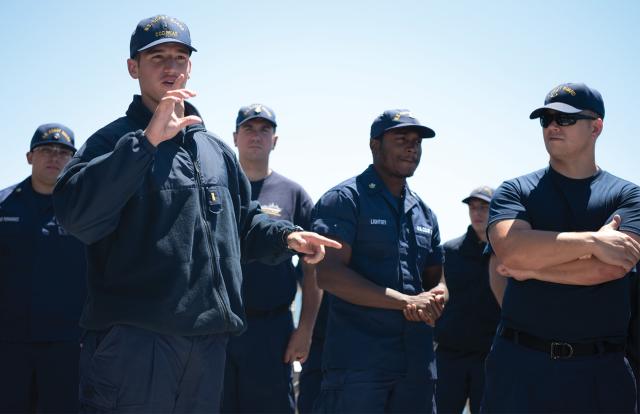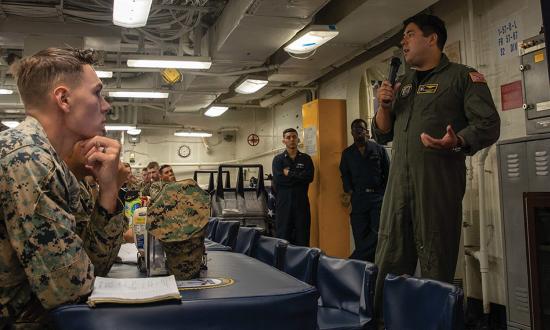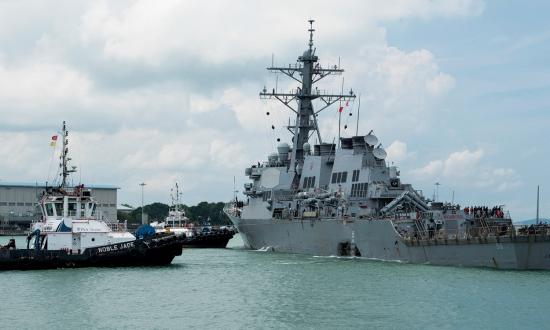When I stepped on the bridge of a Coast Guard cutter for the first time, fingers of ones and twos rose all around. The boatswain’s mate second class then went into poetic detail of how the tropical heat could be taxing for the deckies and to be cognizant of the shoal water on the transit out. I realized that low risk was represented by one finger, moderate risk by two, and three fingers would be the highest degree of risk. This seemingly routine procedure is a perfect example of positive leadership that can combat mishaps by offering a voice to the whole crew—regardless of rank.
“Spatial awareness is key,” Boatswain’s Mate Second Class T. commented on avoiding mishaps. An experienced boatswain’s mate, he has witnessed many such incidents. “There are other contributing factors,” he noted. “But also, the communication could have been lacking.”1 Beyond training and assessments is something irreplaceable: the people behind the uniforms. Look at any mishap and—machinery faults aside—the common denominator is people.
The Human Element
Knowing that civilian first responders face challenges like those in the Sea Services, I was curious about how firefighters promote a culture of health and safety. In my conversation with a member of the Boston Fire Department, an unexpected theme emerged: a focus on the firehouse community versus a rigid fitness program. “We actually don’t have a designated workout routine,” the firefighter told me. “We just know that we have to stay in good shape mentally and physically based on the nature of the work. I won’t be able to pull my 200-plus-pound friend out of a burning building if I’m not strong enough.”2
The firefighter I interviewed happened to be former active-duty Navy and is currently in the Navy Reserve. When asked the main difference between the Navy and the fire department, he replied, “The quality of life and the camaraderie. I’ll be at the same station with the same guys for 20 years. We’re part of the community; we’re part of each other’s families. . . . You can’t break that.”
Having a community and support system is vital for people whose work often involves responding to life-threatening situations. These experiences can lead to high levels of anxiety, stress, and emotional trauma. It is estimated that 30 percent of first responders develop behavioral health conditions, including depression and post-traumatic stress disorder, compared with 20 percent in the general population.3 These conditions can have serious consequences, including impaired job performance, increased risk of suicidal ideation, and decreased vigor for life.
Though the Coast Guard has made strides in destigmatizing mental health services, there are still underlying issues. Service members may feel that seeking mental health help is a sign of weakness or that it may jeopardize their career. I interviewed an aviation survival technician (AST) who was experiencing night terrors after several difficult missions.4 Though struggling, he was unwilling to speak to a professional. This is an ongoing challenge in an environment that emphasizes toughness and resilience. While these qualities are important, they can make it difficult for service members or first responders to seek help. A 2021 study by the U.S. Fire Administration found that 18 firefighters and EMS out of 100,000 had taken their own lives that year.5 Military service members had significantly higher numbers at 24.3 of 100,000.6
The AST went on to say, “I’m grateful and so lucky to have chosen someone to spend the rest of my life with that calls me out on things like this that I needed to address. It was affecting my work and my life at home without me even realizing.” A strong work/life balance allows for physical recuperation along with the mental and emotional benefits of time spent with loved ones. These are basic human needs that contribute to happiness and well-being, which help reduce burnout and encourage stronger work performances.
Happiness is complex and multifaceted. There is no single formula to meeting these basic needs, but in general: Social connections, physical and mental health, and having a sense of meaning and purpose will lead to more positive outcomes. Good leaders and leadership training at all levels can encourage these outcomes.
Leadership
It is important to consider support as well as operational roles. Every rating is important to total mission success, and every department runs the risk of mishaps. Some incidents may result in inventory or pay discrepancies, others could lead to physical injuries. Regardless of the unit, strong leaders can help. U.S. Coast Guard Captain and Proceedings author Marcus A. Canady leads a presentation on intrusive leadership, which challenges service members to check in with one another, regardless of rank. I reached out to Captain Canady in March 2023 to hear his thoughts on the effect of leadership style on safety. He responded:
Intrusive leadership can reduce mishaps by arming operational commanders with a better understanding of human factors that could be impacting their members’ ability to conduct missions in a safe manner. Operational commanders need to know when they might be tasking someone to do something that requires their undivided attention, and they could be dealing with something at home that makes that impossible. Intrusive leadership directly impacts workplace safety as well as so many other aspects of employee satisfaction.
By setting similar leadership examples, service members could come away with a clearer understanding of what is expected of them, and also understand accountability is alive and well within their units.
Prioritizing Safety
Recognizing how leaders can affect a service member’s mental state is only the beginning. An environment that prioritizes safety as a core value and encourages service members to actively participate in identifying and combating risks should be the standard. Safety can be supported by training, clear policies and procedures, and a commitment to continuous improvement. This includes considering sleep schedules during watch rotations and evolutions, along with risk assessments. These assessments should be encouraged on both small and large scales. For example, before moving a pallet of electronics, the forklift operator should conduct his or her own risk assessment. Encouraging autonomy and decision-making is just as critical in training and education as clear communication.
Fostering communication and collaboration among service members could help identify and address issues more clearly and effectively. Minimizing “busy work” maximizes opportunities for dialogue. By making good use of time, supervisors can assist junior service members with their career development and goals. Regular check-ins and evaluations can identify areas for improvement and ensure service members are always striving to be the best versions of themselves personally and professionally.
The biggest lesson to take away from mishaps is the need for stronger communication and for service members to be more intentional with their actions. To be successful, the Coast Guard needs to focus on things it can control—the collective health and well-being of its service members.
1. Boatswain’s Mate Second Class T., phone interview with author, March 2023.
2. Boston firefighter, in person interview with author, March 2023.
3. Substance Abuse and Mental Health Services Administration, “First Responders: Behavioral Health Concerns, Emergency Response, and Trauma,” Disaster Technician Assistance Center Supplemental Research Bulletin (May 2018).
4. Aviation Survival Technician, phone interview with the author, 26 March 2023.
5. U.S. Fire Administration, Firefighter Suicide Reporting, U.S Department of Homeland Security, fiscal year 2021 report to congress (30 November 2021).
6. Under Secretary of Defense for Personnel and Readiness, Department of Defense Annual Report on Suicide in the Military, U.S. Department of Defense (November 2021).









